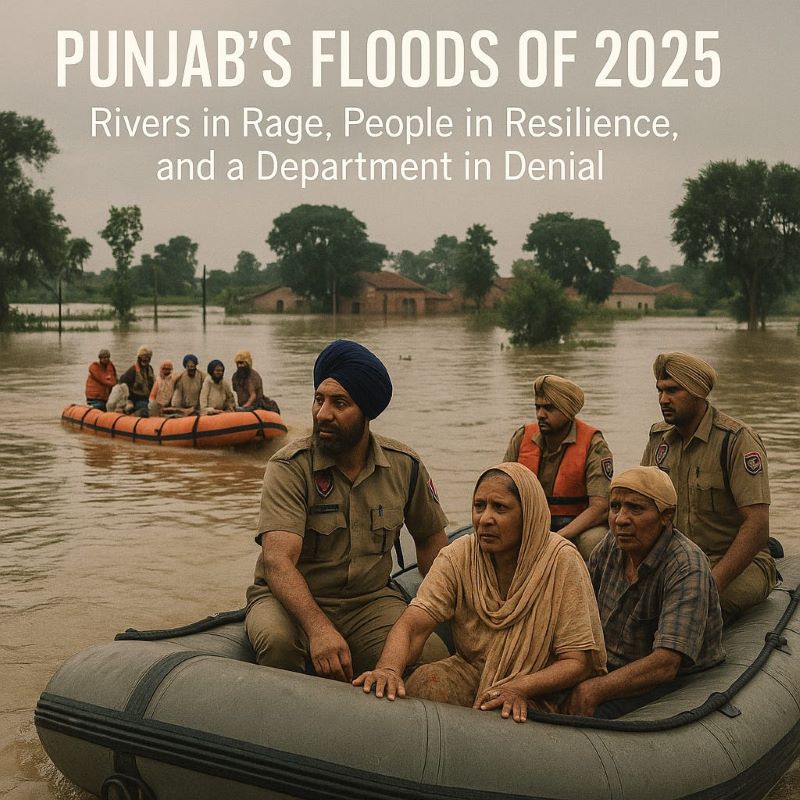 The monsoon of 2025 has once again humbled Punjab. The state that feeds the nation found itself feeding on resilience, courage, and community spirit as its rivers roared out of control. Yet as the waters rose, what became strikingly clear was a stark contrast: the political leadership and district administration stood tall, while the state’s Irrigation and Water Resources Department, constrained by chronic neglect from the Finance Department, revealed itself as the weakest link in Punjab’s fight against the floods.
The monsoon of 2025 has once again humbled Punjab. The state that feeds the nation found itself feeding on resilience, courage, and community spirit as its rivers roared out of control. Yet as the waters rose, what became strikingly clear was a stark contrast: the political leadership and district administration stood tall, while the state’s Irrigation and Water Resources Department, constrained by chronic neglect from the Finance Department, revealed itself as the weakest link in Punjab’s fight against the floods.
This is not a story of weather alone. The rain may be an act of God, but the flood was also an act of man—of bureaucracy, of misplaced priorities, and of years of delayed repairs and deferrals.
Ravi: Madhopur’s Missed Moment
Every flood season has its flashpoint, and in 2025 it was the Madhopur Barrage on the Ravi. For decades, Madhopur has been Punjab’s northern sentinel, controlling flows from Ranjit Sagar and Shahpur Kandi. But this year, instead of being the state’s shield, it became its Achilles’ heel.
When floodwaters surged down the Ravi, reports emerged that gates at Madhopur were not opened in time. Water backed up, inundating villages upstream and destroying thousands of acres of crop. In an extraordinary twist, parts of the barrage itself were damaged, prompting the Army and Air Force to mount rescue operations on the very headworks meant to protect Punjab. That image—soldiers rescuing civilians from a failing barrage—captures the institutional decay of the department tasked with keeping our rivers in check.
For years, engineers knew that Madhopur’s ropes, counterweights, and regulators were worn out. Maintenance files circulated, tenders were floated, but repairs were pushed into the bureaucratic future. When it mattered, the system faltered. The district administration had no choice but to fight the human consequences—evacuating villages, setting up relief camps, and facing angry farmers—while the engineers who should have prevented this mess retreated behind paperwork and excuses.
The Irrigation and Water Resources Department must be held accountable. This was not just a natural disaster; it was a failure of vigilance, preparation, and duty.
Shahpur Kandi Dam Project on Ravi, downstream Ranjit Sagar Dam: 4th February, 2023 pics. Awaiting full operation.
Beas: The People and Their Commissioners
If Madhopur was a symbol of failure, the Beas river became a symbol of resilience. As Pong Dam crossed its full reservoir level and discharges thundered downstream, the Mand belt in Sultanpur Lodhi became the front line. Embankments threatened to collapse, paddy fields trembled under the rising torrent, and the night could have ended in disaster.

Karan Bir Singh Sidhu, IAS (Retd.), former Special Chief Secretary, Punjab, writes on the intersection of constitutional probity, due process, and democratic supremacy.
It did not—because Punjab’s Deputy Commissioners and District Police Chiefs acted with urgency and courage. They did not wait for engineers to arrive with technical jargon. They mobilised villagers, tractors, sandbags, and earthmovers. They stood shoulder-to-shoulder with ordinary people, working through the night to keep bunds intact. This was administration at its best—visible, decisive, and human.
The state government, to its credit, acted quickly. The Chief Minister ordered special girdawari assessments and released funds on the spot. Ministers fanned out district-wise to reassure communities. Relief kitchens were set up in gurdwaras and schools became shelters. The message was clear: the government was not distant, it was present.
But the embankments themselves tell another story. They remain fragile, patched year after year, ignored until crisis strikes. Villagers should not have to risk their lives with sandbags while the Irrigation Department, which should be reinforcing these bunds pre-monsoon, confines itself to reports and excuses.
Sutlej: Harike’s Hinge and Ferozepur’s Fear
The Sutlej carried its own fury, swollen by Bhakra’s releases. At Harike, the great confluence where the Sutlej meets the Beas, waters surged and shifted dangerously, threatening to spill downstream into Ferozepur and Fazilka. Villages there lived for days under the shadow of evacuation.
Again, it was the district machinery that responded with foresight. Advisories were issued, people were moved to higher ground, pumps were pre-positioned, and police ensured orderly evacuations. When the bunds showed seepage, it was local administrators and panchayats who rushed to reinforce them.
Yet the larger picture is troubling. The Sutlej is one of the most studied rivers in India, with decades of hydrological data. Yet embankments here remain vulnerable to rodents, seepage, and erosion. Drainage systems are choked with silt and encroachment. Instead of upgrading defenses for a climate-changed monsoon, the Irrigation Department has been content with recycling old schemes and waiting for files to clear Finance. It is a system where lethargy has been institutionalised.
Ghaggar: The Forgotten Stream
The Ghaggar, often dismissed as a seasonal rivulet, once again showed how dangerous neglect can be. In Sangrur, Mansa, and Patiala, sudden surges turned fields and homes into pools. The Ghaggar’s narrow channel, long encroached upon and never properly dredged, simply could not handle the rain.
The district administrations did their best—clearing culverts, patrolling dhussis, moving people—but the larger problem remains unaddressed. For decades, governments have promised a permanent solution to the Ghaggar menace. For decades, the Irrigation Department has dithered. Every monsoon, villagers pay the price.
Farmers in the Firing Line
At the heart of this tragedy lie Punjab’s farmers. Over 90,000 acres lie submerged by official count; the real figure is likely far higher. Fazilka’s cotton fields, the pride of Punjab, are ruined. Cotton does not forgive standing water, especially during flowering and boll formation. Weeks of waterlogging mean total crop loss. Paddy, though somewhat sturdier, has suffered lodging and soil erosion that will slash yields. Add to this fodder shortages, livestock losses, and damaged infrastructure, and the picture is grim.
The government has moved quickly. Special girdawaris are under way, ministers have been deployed to supervise, and compensation has been promised in full. Farmers, even while distressed, know at least that the state stands by them. But the bitter truth is this: much of their loss could have been prevented had the Irrigation Department done its job. It is not enough to pay compensation after the fact; farmers deserve protection before disaster strikes.
A Tale of Two Administrations
The floods of 2025 have exposed two faces of Punjab’s governance. On one side stand the political leadership and district administrations: visible, responsive, empathetic, and brave. The Chief Minister released funds without delay, ministers toured flooded areas, and Deputy Commissioners and Police Chiefs waded into the water themselves to rescue and reassure. This is governance at its best.
On the other side stands the Irrigation and Water Resources Department, supported by a Finance Department that chronically starves it of resources until the last moment. From the Secretariat to the field engineers, the Department has shown complacency bordering on negligence. Reports are written, but repairs are delayed. Gates are rusting, but tenders are postponed. Embankments are patched, but not rebuilt. In the hour of crisis, it is the villagers, the police, and the Deputy Commissioners who save Punjab—not the engineers whose duty it is to prevent the flood in the first place.
Penultimate Paragraph
Right now, it is not the time to point fingers at the government, the district administration, or even the Centre. The hour demands that everyone—politicians, including those of the opposition, officers, civil society, and citizens—get down to the spot and follow the classic order of the three R’s: Rescue, Relief, and Rehabilitation. That is the immediate priority. But let us not forget: what happened in 1988, again in 2023, and now in 2025 must not be allowed to repeat. With climate change accelerating, things will only get worse. Preparedness, planning, and resilience must become our way of life.
Final Word: The Department Must Change or Go
When the waters recede, Punjab must ask itself a hard question: can it afford an Irrigation Department that cannot open gates on time, cannot maintain barrages, cannot protect embankments, and cannot clear drains? The Deputy Commissioners and Police Chiefs have shown what public service looks like. The political leadership has shown what accountability looks like. It is time the Irrigation and Water Resources Department, from its senior secretariat mandarins to its engineering cadre, learned the same lesson—or made way for those who can.
Punjab’s rivers will flood again. That is inevitable. What is not inevitable is that the state should be unprepared. The floods of 2025 must be remembered not just as a natural calamity, but as the year when Punjab finally demanded accountability from the very Department that holds its rivers in trust. If that change happens, the sacrifice and suffering of this monsoon will not have been in vain.